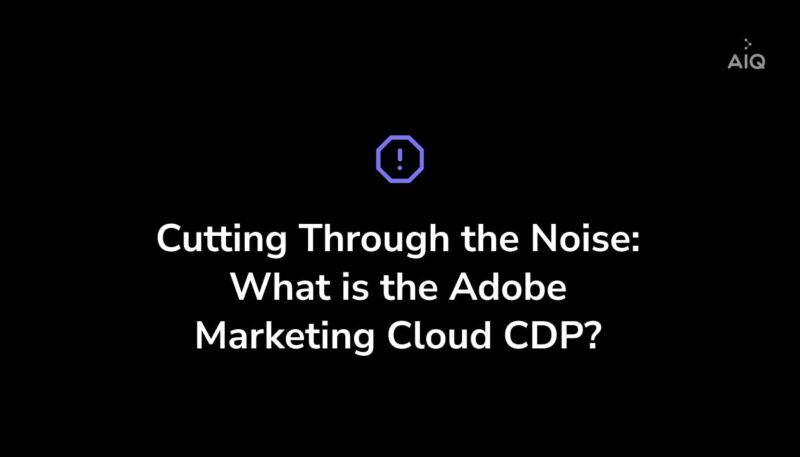What is the Adobe Marketing Cloud CDP?

The customer data platform (CDP) market is confusing — but it doesn’t have to be. This is part 1 in a series of blog posts exploring different types of CDP vendors, how their products differ from other technologies and what you can do to select the right CDP for your enterprise company.
If you are new to CDPs, be sure to read our in-depth article, “What is a CDP?”
The Adobe Marketing Cloud CDP is among the most well known in terms of brand recognition, as Adobe is a legacy brand with a long history of providing software for printing and publishing. But being well-known is not the same as being well-understood.
The Adobe Marketing Cloud, of which the Adobe CDP is one product offering among many, operates similarly to other marketing clouds. It’s a portfolio of point solutions brought together under one roof. Marketing cloud point solutions — which are often the result of vendor acquisition — are ostensibly designed to operate on their own, but this isn’t always the case in practice.
Who is the Adobe Marketing Cloud CDP for?
The Adobe CDP, known as the Adobe Experience Platform, is geared toward data teams within IT departments — not everyday business users. Technical users configure the Adobe CDP to stitch together customer identity data and push the resulting customer 360 to the Adobe Marketing Cloud’s different point solutions.
Because of the massive licensing and support costs required to make it work, the Adobe CDP appeals most to enterprise organizations that have already heavily invested in other Adobe Marketing Cloud point solutions.
How Do You Use the Adobe Marketing Cloud CDP?
The Adobe CDP behaves similarly to a walled garden, meaning users are discouraged from exporting customer data to non-Adobe tools. There’s a lower cap on how much data you can export to non-Adobe tools versus those that are part of the Adobe Marketing Cloud, and you’ll be charged for exceeding it.
Additionally, using the Adobe CDP for tasks beyond data management — such as predictive analytics, customer journey automation and offer decisioning — requires licensing upwards of four of their other products and potentially 10 SKUs, ruling out the best-of-breed approach preferred by 56% of marketing technology buyers. Data science activities, access to query service and API integrations all require additional licenses.
What Are the Pros & Cons of the Adobe Marketing Cloud CDP?
The Pros:
Because the Adobe Marketing Cloud has point solutions for different channels, such as email and advertising, the Adobe CDP appears to excel at both the design and delivery of multi-channel campaigns during product demonstrations (as long as you have the ancillary tools to assist with final-mile delivery). Additionally, the Adobe CDP has solid dashboarding capabilities to help you track and summarize data via prebuilt tools or connections with data visualization softwares. Adobe CDP also provides a set of capabilities to ingest, process and activate real-time data with RTCDP.
The Cons:
But stringent data formatting requirements and disjointed architecture reliant on separate codebases and schema mean the Adobe CDP struggles to deliver on the speed, accuracy and scale enterprise companies demand — leading some analysts to refer to it as “feature-thin and structurally underdeveloped.”
For example, in terms of facilitating and orchestrating a strong and personalized customer experience, its overly complex design — which relies on an ecosystem designed for Adobe tools and requires significant technical resources — hinders marketing agility and automation.
Due to these limitations, the Adobe CDP is time-consuming to deploy and use. And beyond the high initial cost of investing in it, brands must plan for the extra costs of ingesting data from or delivering personalized experiences to sources outside the Adobe Marketing Cloud — either by building their own APIs, paying Adobe to build them or purchasing an integration platform. This is in addition to the expenses associated with technical resources to standardize and transform data before it enters the Adobe CDP.
The vendor lock-in component of the Adobe Marketing Cloud also has a massive impact on innovation. Marketing cloud contracts make it difficult for users to swap out their aging solutions for newer, more effective technologies — a significant obstacle for the 67% of marketers who add new types of technologies to their martech stacks either monthly or quarterly and are seeking a composable solution.
How Does ActionIQ Compare to the Adobe Marketing Cloud CDP?
Unlike the Adobe CDP, ActionIQ supports a plug-and-play approach to martech management, enabling enterprise businesses to easily implement new technology that supports strategic innovation and personalized customer experiences across channels. ActionIQ also integrates seamlessly with Adobe products and increases the value of a client’s Adobe stack (more than the Adobe CDP).
With unlimited computation power via our proprietary composable architecture plus a user-friendly UI designed for non-technical business users, enterprise brands can quickly access and take action on accurate customer data while using best-of-breed point solutions for final-mile experience delivery — including our own integration with Adobe point solutions, if that’s the organizational preference.
And because business users are able to analyze audiences and orchestrate automated experiences on the fly without support from technical resources, they’re able to streamline operations while cutting costs — reducing data analyst workload by 40% and driving a 522% return on investment.
Stay tuned for part 2 in this blog series, where we’ll explore the Salesforce Marketing Cloud CDP.
Learn More
Download our CDP Market Guide to learn more about different types of CDPs or contact one of our experts to see how ActionIQ differs from Adobe and other marketing cloud CDPs.
You can also check out how ActionIQ increases the value of your Adobe stack.





